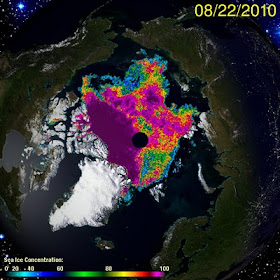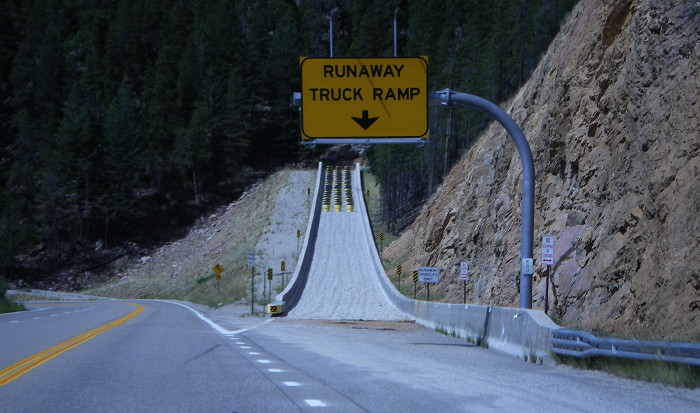Ethon flew back from Boulder with long stopovers in Denver, and Lord help him O'Hare. He's been getting old and peckish, and has taken to flying commercial for long hauls. Except for the food (no liver, never), he doesn't complain much. So the Bird and Eli were sitting around discussing knowledge and the difference between Philosophy, Policy, Science and Politics, you know, Honest Broker stuff. Eli thought that it was really simple, Philosophy is thinking about what should be, and Science is thinking about what is. Policy is reconciling the two, and Politics, Politics is
Jindal Berm Theology, or as
Roger Jr. said to Ethon, getting elected is the only thing that counts.
Ever since he was a little kit, Eli has been hearing from the Jindal Berm School, about how 1970s science predicted a new ice age was on the way.
Stoat has a cute little vanity page on the subject, and occupying pride of place, the number one "proof", the Euro-cooling Journal Article Contest Winner, has always been Rasool and Schneider, Science (1971) 138 "Atmospheric Carbon Dioxide and Aerosols: Effects of Large Increases on Global Climate".
This, of course, is the paper which birthed the term "to be Rasooled", as denialists world wide Rasool Rasool, disappearing him down the citation hole and always refer to this as the late Stephen Schneider's paper. This is quite amusing as S. Ichtiaque has turned in to a Pielke Sr. clone, but then he never liked Jim Hansen much after hiring him. Turns out they might be right, as we shall see, yet Schneider was a young postdoc at the time, Rasool was the senior author.
So at last we come to the point of this post, how does science correct itself, and indeed it has, the consensus value of ~ 3 K/ CO2 doubling has been consistently reaffirmed many times in many ways, and the arms of the black knight, the very high (above 5K) and very low (below 2K) chopped off as improbably with numerous lines of evidence. Of course, the black knights, such as low end Lindzen keep on trying. So how are these appendixes (the vestigial useless organs) dealt with. They remain in print. Almost none are challenged in comments, but in a small community, everyone knows, word passes. However, as climate has become a policy issue with a much larger audience, this is no longer working, which accounts for the increased number of comments on seriously flawed papers and so, Eli adds a bit to the hysterical record.
As just about everyone knows, Rasool and Schneider used too low a value of the climate sensitivity to CO2 increase, although their aerosol sensitivity was not bad and that, it is important to know, was a significant contribution. A footnote, added probably at the insistence of the editor, points out that others found much larger CO2 sensitivities, which would more or less be the IPCC recommendation, 2-4.5 K for CO2 doubling.
Using their sensitivities, Rasool and Schneider tried to estimate future aerosol increases from fossil fuel burning and other sources and concluded that this
should raise the present background opacity by a factor of 4, our calculations suggest a decrease in global temperature by as much as 3.5 oC. Such a large decrease in the average temperature of Earth, sustained over a period of few years, is believed to be sufficient to trigger an ice age. However, by that time, nuclear power may have largely replaced fossil fuels as a means of energy production."
This is just about the only such prediction in the scientific literature, but has given rise to a cottage industry of claims.
In the natural course of science, it was quickly and conclusively established by other calculations that R&S's value for climate sensitivity was too low, and the higher values, close to the current consensus ones were correct, and there was no danger of a new ice age. Why Eli put that in bold will soon become clear, but what it does show is the effective way that science has of correcting such mistakes.
UPDATE: And as we shall see, Schneider himself soon, ok, relatively soon, corrected the error.
Still, where did that estimate for low CO2 sensitivity come from? Eli found
the smoking gun in a 2000 AIP oral history interview by Spencer Weart with Jim Hanson (emphasis added)
Weart: You’ve known Schneider from way back, you said?
Hansen: Yes.
Weart: In what sense? Did you run into him at meetings?
Hansen: No, no. He was a student. He actually got his degree in engineering, but he got introduced to this topic by Ichtiaque Rasool, who was the guy who was later attacking me. The guy who got me my job and was attacking me, referring to our earlier situation. So Ichtiaque got Steve to work as a post-doc under him, I believe it was just after Steve graduated from Columbia. They wrote a paper on the effect of aerosols on climate, and ended up saying that the Earth may be headed towards the next Ice Age. I actually helped Steve with his calculations because he was not really a radiation transfer person, so I gave him equations for the scattering the solar part of the problem. He did the thermal part of the problem, and actually, he did a kind of slightly sticky CO2 calculation. He understated the greenhouse effect by a factor of two or so. We later figured out looking at his computer program that it was his mistake.
Weart: I’m curious. What was it?
Hansen: Just his calculation of the infrared opacity of the greenhouse gas greenhouse gas, CO2, was wrong.
Weart: Problem with the data?
Hansen: You’d have to ask Andy. I don’t remember the details. Andy Lacis, he’ll probably remember. What was the point? Oh, Steve Schneider. He and I went with my wife, climbing on Storm King Mountain. So we were pretty good friends.
UPDATE: Below, in the comments, Kooiti Masuda points out that
Schneider discussed in his paper in 1975 the sensitivity of climate to CO2 based on several studies available then, including Rasool and Schneider 1971.
S.H. Schneider, 1975: On the carbon dioxide-climate confusion. J. Atmos. Sci., 32, 2060 - 2066.
He introduced "A useful surface temperature-CO2 concentration sensitivity parameter". Though I am not sure whether this is the very first paper to discuss it, I think we can say the paper started discussion about that parameter popular (among experts). The paper is referred to as "in press" by Broecker's 1975 "Global Warming" paper (which is discussed recently by Stefan R. in RealClimate). I think the assessment of CO2-climate sensitivity by Schneider convinced Broecker the outlook of warming.
Schneider 1975 said that Rasool and Schneider 1971 underestimated the CO2-climate sensitivity, and listed three reasons. The first included the same key word "IR (infrared) opacity" as in Hansen's talk, and I guess that both point to the same thing. The other two are more technical and I have not understood them yet. I quote the first point (p.2063).
"1) The increased CO2 increases IR cooling to space in the stratosphere (which decreases the stratospheric temperature) and increases stratospheric IR opacity. Since Rasool and Schneider maintain constant stratospheric temperature even after CO2 is doubled, their model's stratosphere emits too much infrared radiation to space. This, combined with the constraint of planetary radiation balance at the top of the atmosphere, results in a compensation process by which their model's troposphere does not warm sufficiently. This effect was modeled by Manabe and Wetherald [1967] and not by Rasool and Schneider, and, as explained by the next section [Section 3], accounts for roughly 0.5 K of the 1.6 K difference in Γ2 estimates."
As Eli was saying









